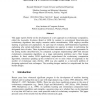Free Online Productivity Tools
i2Speak
i2Symbol
i2OCR
iTex2Img
iWeb2Print
iWeb2Shot
i2Type
iPdf2Split
iPdf2Merge
i2Bopomofo
i2Arabic
i2Style
i2Image
i2PDF
iLatex2Rtf
Sci2ools
IIS
2000
2000
Speeding Up Evolution through Learning: LEM
This paper reports briefly on the development of a new approach to evolutionary computation, called the Learnable Evolution Model or LEM. In contrast to conventional Darwinian-type evolutionary algorithms that employ mutation and/or recombination, LEM employs machine learning to generate new populations. At each step of evolution, LEM determines hypotheses explaining why certain individuals in the population are superior to others in performing the designated class of tasks. These hypotheses are then instantiated to create a next generation. In the testing studies described here, we compared a program implementing LEM with selected evolutionary computation algorithms on a range optimization problems and a filter design problem. In these studies, LEM significantly outperformed the evolutionary computation algorithms, sometimes speeding up the evolution by two or more orders of magnitude in the number of evolutionary steps (births). LEM was also applied to a real-world problem of design...
Evolutionary Computation | Evolutionary Computation Algorithms | IIS 2000 | IIS 2001 | LEM Employs Machine |
| Added | 01 Nov 2010 |
| Updated | 01 Nov 2010 |
| Type | Conference |
| Year | 2000 |
| Where | IIS |
| Authors | Ryszard S. Michalski, Guido Cervone, Kenneth A. Kaufman |
Comments (0)

